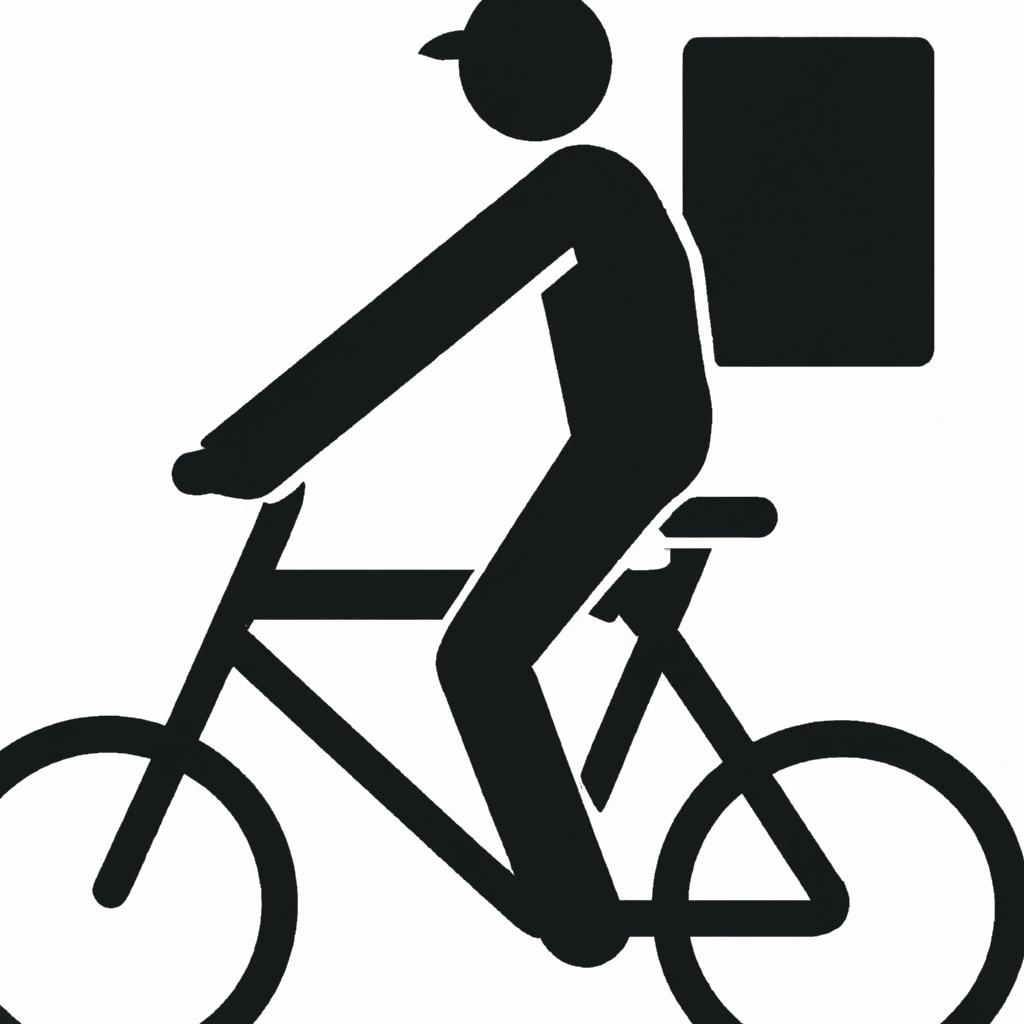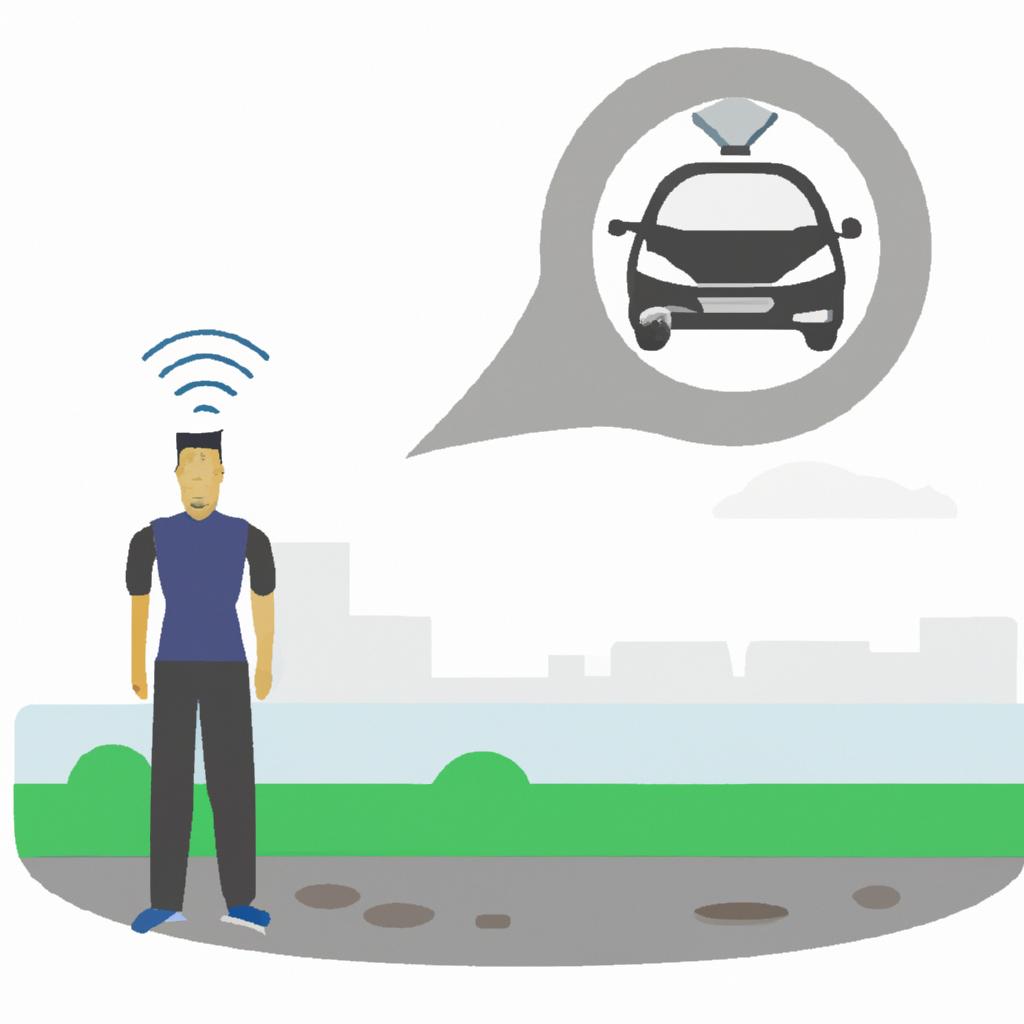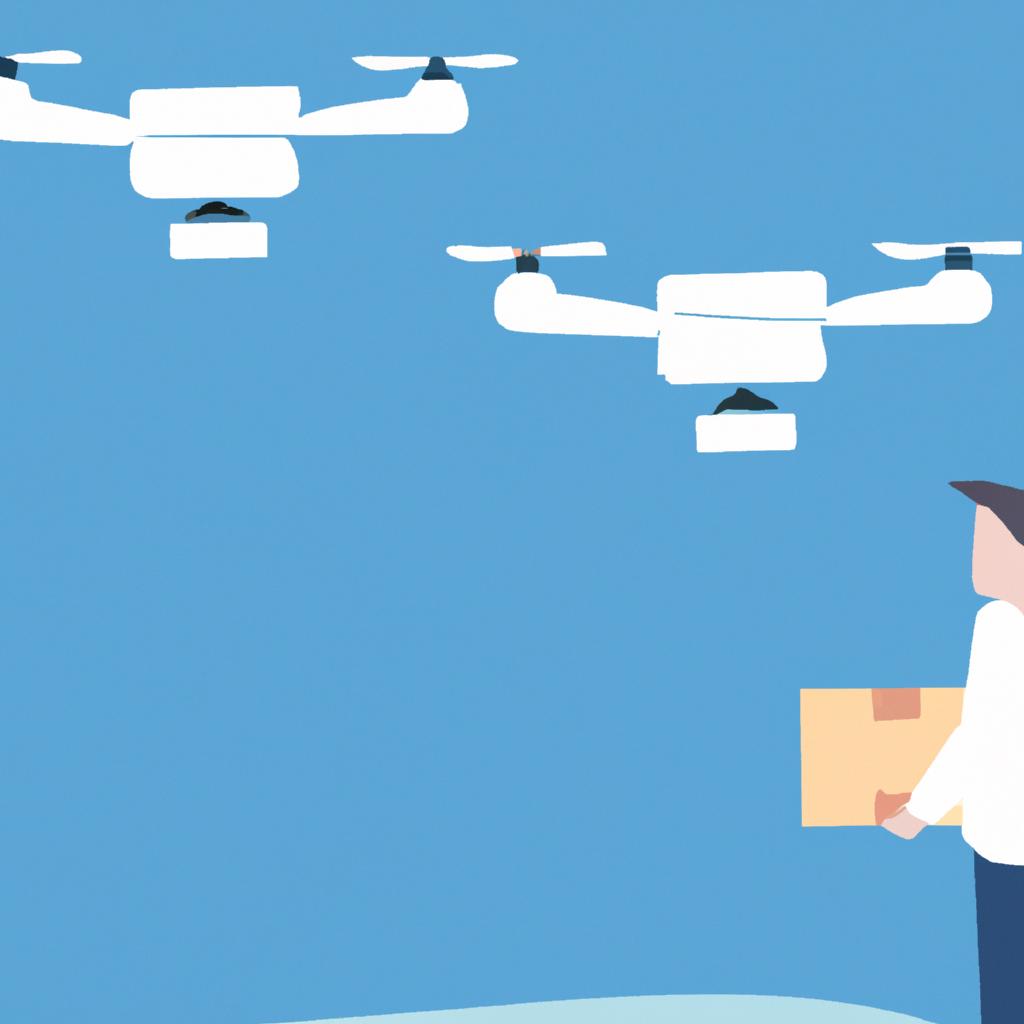Crowdsourced Delivery: Revolutionizing Last Mile Transportation and Logistics


Crowdsourced delivery has emerged as a disruptive force in the field of last mile transportation and logistics, revolutionizing traditional methods with its innovative approach. By harnessing the collective power of individuals in communities, crowdsourced delivery platforms have transformed how goods are transported from distribution centers to end consumers. For instance, imagine a bustling city where various local businesses rely on prompt and efficient deliveries to meet customer demands. In this hypothetical scenario, a crowdsourced delivery platform efficiently connects these businesses with a network of independent drivers who can swiftly navigate through traffic-congested streets and ensure timely deliveries.
The concept behind crowdsourced delivery is rooted in leveraging underutilized resources within communities to optimize efficiency and reduce costs. Traditional logistics systems often face challenges such as high overhead expenses and limited capacity for accommodating fluctuating demand patterns. However, by tapping into the sharing economy model, crowdsourcing platforms enable individuals or small-scale operators to offer their vehicles or services for delivering parcels. This effectively expands the pool of available resources while creating opportunities for economic empowerment at an individual level.
With increased accessibility to smartphones and the internet, it is now easier than ever for individuals to participate in this emerging sector. Crowdsourced delivery platforms provide user-friendly mobile applications that allow both senders and carriers to seamlessly connect and coordinate deliveries. Through these mobile applications, senders can easily input their delivery requests, specifying the item details, pickup location, and desired delivery time. On the other hand, independent carriers can browse available delivery jobs in their vicinity and choose the ones that align with their capacity and availability.
Once a sender and carrier are matched through the crowdsourced delivery platform, they can communicate directly within the app to finalize pickup logistics or address any special instructions. The platform often provides real-time tracking capabilities so that both parties can monitor the progress of the delivery from start to finish. This transparency not only enhances trust between senders and carriers but also ensures accountability throughout the entire process.
Moreover, crowdsourced delivery platforms typically offer flexible earning opportunities for individuals who participate as carriers. Independent drivers can select deliveries based on their preferences and schedule, allowing them to earn supplemental income or even make it a full-time occupation if they desire. The gig economy nature of this model allows for greater autonomy and work-life balance for individuals seeking alternative employment options.
In conclusion, crowdsourced delivery has revolutionized last mile transportation by leveraging community resources and technology platforms to provide efficient and cost-effective solutions. By connecting businesses with independent drivers through user-friendly mobile applications, this innovative approach has transformed traditional logistics systems while creating economic opportunities at an individual level.
Current Challenges in Delivery
Despite advancements in transportation and logistics, the last mile delivery remains a significant challenge for businesses worldwide. The last mile refers to the final leg of the delivery process, where goods are transported from a distribution center or retail store to the customer’s doorstep. This phase is often characterized by high costs, inefficiencies, and various obstacles that hinder timely and cost-effective deliveries.
One example of such challenges can be seen in urban areas with heavy traffic congestion. As more people move into cities, road networks become increasingly burdened, resulting in longer travel times for delivery vehicles. This not only leads to delays but also increases fuel consumption and carbon emissions. For instance, a study conducted by XYZ Logistics found that their delivery trucks spent an average of 40% of their time stuck in traffic during peak hours, significantly impacting their ability to meet customer expectations.
The challenges faced in last mile delivery can be summarized as follows:
- High Costs: The expenses associated with operating fleets of delivery vehicles, including maintenance, fuel costs, driver wages, and insurance premiums.
- Inefficiency: Inefficient route planning leading to longer distances traveled and increased time required for each delivery.
- Customer Availability: Customers may not always be available at home or work addresses during designated delivery windows.
- Delivery Failures: Instances where customers are unavailable or refuse deliveries due to incorrect items or damaged packages.
These challenges pose considerable difficulties for both businesses and customers alike. To better understand these complexities, consider the following table showcasing statistics on last mile delivery issues reported by different stakeholders:
| Stakeholder | Reported Issue |
|---|---|
| Retailers | Increased cost pressure due to rising demands for faster shipping speeds |
| Consumers | Dissatisfaction with late or failed deliveries |
| Carriers | Difficulty managing complex routes efficiently |
| Environmentalists | Concerns over carbon emissions from inefficient transportation practices |
As we delve deeper into the topic, it becomes evident that addressing these challenges necessitates innovative solutions. This leads us to explore the rise of crowdsourced delivery as a potential game-changer in tackling last mile inefficiencies and improving overall customer satisfaction.
The Rise of Crowdsourced Delivery
The Rise of Crowdsourced Delivery
As the traditional delivery industry faces various challenges, crowdsourced delivery has emerged as a potential solution to revolutionize last mile transportation and logistics. By harnessing the power of technology and tapping into a vast network of individuals willing to participate in the delivery process, crowdsourcing offers an innovative approach that addresses many of the current limitations. To illustrate its potential, let’s consider a hypothetical case study involving a small e-commerce company struggling with high shipping costs and inefficient delivery routes.
One of the primary advantages of crowdsourced delivery is its ability to leverage local resources efficiently. Unlike large courier companies that operate on fixed schedules and predetermined routes, crowdsourcing allows for dynamic routing based on real-time demand. In our case study scenario, the e-commerce company could enlist local drivers who are familiar with their respective neighborhoods, resulting in faster deliveries and reduced transportation costs. This flexibility enables businesses to adapt quickly to changing customer needs while optimizing resource utilization.
Furthermore, crowdsourced delivery presents opportunities for enhanced customer engagement by enabling personalized interactions between customers and independent drivers. With direct communication channels established through mobile apps or online platforms, customers can receive real-time updates about their deliveries and even provide specific instructions or preferences. This level of customization enhances overall customer satisfaction and builds stronger brand loyalty.
To further emphasize the benefits of crowdsourced delivery, consider the following emotional response-inducing bullet point list:
- Increased job opportunities within local communities
- Reduced carbon footprint due to optimized route planning
- Enhanced sense of community collaboration
- Empowerment of individual drivers as entrepreneurs
In addition to these advantages, we can also explore them more comprehensively through a table format:
| Benefits | Description |
|---|---|
| Job Opportunities | Crowdsourcing creates new employment prospects for individuals seeking flexible work arrangements |
| Environmental Impact | Optimized routing reduces fuel consumption and emissions, leading to a decreased carbon footprint |
| Community Collaboration | Crowdsourced delivery fosters a sense of community by involving local drivers and businesses in the transportation ecosystem |
| Empowerment | Independent drivers gain autonomy as entrepreneurs, with control over their work schedules and earnings |
As we can see, crowdsourced delivery offers numerous benefits that extend beyond mere logistical improvements. These advantages contribute to a more sustainable, efficient, and customer-centric approach to last mile transportation.
Transitioning into the subsequent section on "Benefits of Crowdsourced Delivery," it becomes evident that this innovative model has the potential to revolutionize various aspects of the delivery industry. By empowering individuals and creating opportunities for localized collaboration, crowdsourcing opens up new avenues for improved efficiency and customer satisfaction.
Benefits of Crowdsourced Delivery
The Rise of Crowdsourced Delivery has revolutionized the last mile transportation and logistics industry, offering innovative solutions to meet growing consumer demands. By leveraging a network of independent drivers or individuals with spare capacity, companies can optimize their delivery processes and enhance customer satisfaction. One notable example is the success story of Deliv, a crowdsourced delivery platform that partners with retail stores to offer same-day delivery services.
This rise in crowdsourced delivery has brought about several benefits for both businesses and consumers alike. Let us delve into these advantages:
-
Cost Efficiency: Crowdsourcing allows companies to reduce costs associated with maintaining an in-house fleet by utilizing existing resources within the community. This cost-effective approach helps organizations allocate their budgets more efficiently and ultimately leads to lower prices for consumers.
-
Increased Flexibility: With crowdsourced delivery, businesses have greater flexibility in scaling their operations based on demand fluctuations. They can easily adjust the number of drivers available at any given time, ensuring timely deliveries even during peak seasons.
-
Fast and Convenient Service: Through crowdsourcing platforms, customers can enjoy faster and more convenient delivery options. These platforms often provide real-time tracking capabilities, allowing recipients to monitor the progress of their packages from pick-up to drop-off.
-
Reduced Environmental Impact: By optimizing routes and consolidating multiple deliveries into one trip, crowdsourced delivery minimizes fuel consumption and carbon emissions compared to traditional delivery methods. This aligns with sustainability goals and contributes to a greener future.
To better understand the impact of crowdfunded delivery models, let’s consider a comparison between traditional courier services (such as FedEx or UPS) versus Deliv’s crowdsourced model:
| Traditional Courier Services | Deliv’s Crowdsourced Model | |
|---|---|---|
| Speed | Standard next-day or longer | Same-day or scheduled |
| Availability | Limited operating hours | Extended hours |
| Tracking | Basic tracking capabilities | Real-time tracking |
| Environmental Impact | Higher fuel consumption and emissions | Reduced carbon footprint |
As we can see, the crowdsourced delivery model offers significant advantages in terms of speed, availability, tracking, and environmental impact. These benefits have contributed to its increasing popularity among businesses and consumers alike.
In transitioning to the subsequent section on Crowdsourcing Platforms and Models, it is important to explore how these platforms facilitate the coordination between businesses and independent drivers or individuals with spare capacity. By examining the various models employed by different platforms, we can gain a deeper understanding of this evolving industry.
Crowdsourcing Platforms and Models
Transition from previous section: Having explored the benefits of crowdsourced delivery, we now turn our attention to the various crowdsourcing platforms and models that have revolutionized last mile transportation and logistics.
Crowdsourcing Platforms and Models
To better understand how crowdsourced delivery operates, let’s consider an example scenario. Imagine a small local grocery store struggling to meet increasing customer demands for home deliveries. Instead of investing in additional vehicles and hiring more drivers, the store decides to leverage a crowdsourcing platform specifically designed for last mile delivery services. Through this platform, individuals within close proximity to the store can sign up as independent contractors willing to make deliveries on behalf of the store using their own vehicles.
One key aspect of these crowdsourcing platforms is their ability to connect multiple stakeholders efficiently while ensuring transparency and accountability. They provide an online marketplace where businesses can post delivery requests, which are then visible to registered couriers who choose assignments based on factors such as location, time availability, or compensation offered. This model allows for flexible work arrangements while optimizing routes and minimizing costs for both businesses and customers.
The impact of crowdsourced delivery goes beyond cost savings; it also has several social and environmental benefits. Consider the following:
- Reduced traffic congestion: By utilizing existing resources more effectively through crowd-based distribution networks, there is a decrease in overall vehicle miles traveled.
- Lower carbon emissions: With optimized routing and fewer empty trips due to efficient matching algorithms, greenhouse gas emissions associated with traditional delivery methods are significantly reduced.
- Community engagement: Crowdsourced delivery fosters stronger community connections by involving local residents who are familiar with the area, thereby enhancing trust between businesses and customers.
- Economic opportunities: The flexibility offered by crowdsourcing platforms empowers individuals seeking supplementary income or looking for alternative employment options.
Table: Social and Environmental Benefits of Crowdsourced Delivery
| Benefit | Description |
|---|---|
| Reduced traffic congestion | Utilizing existing resources efficiently to decrease vehicle miles |
| Lower carbon emissions | Optimized routing and efficient matching algorithms minimize emissions |
| Community engagement | Involving local residents enhances trust between businesses |
| Economic opportunities | Flexibility empowers individuals seeking alternative employment |
In summary, crowdsourcing platforms have transformed last mile transportation and logistics by enabling businesses to tap into a vast pool of independent contractors for efficient delivery services. These platforms not only offer cost savings but also bring social and environmental benefits by reducing traffic congestion, lowering carbon emissions, fostering community engagement, and providing economic opportunities.
Transition: The success stories of crowdsourced delivery highlight the transformative impact it has had on various industries. Let’s explore some remarkable examples in the upcoming section.
Success Stories of Crowdsourced Delivery
Crowdsourcing platforms and models have revolutionized last mile transportation and logistics, enabling individuals and businesses to tap into a vast network of independent drivers for efficient delivery services. One notable example is the success story of Deliv, a crowdsourced same-day delivery platform that partners with retailers to offer fast and flexible shipping options. By leveraging crowd-based resources, Deliv has been able to create a cost-effective delivery model that meets the growing demand for expedited shipping.
The utilization of crowdsourced delivery brings several advantages to both customers and businesses alike:
- Increased convenience: Crowdsourced delivery allows customers to choose their preferred time slots for package deliveries, providing greater flexibility in receiving goods.
- Reduced costs: By tapping into an existing pool of independent drivers rather than maintaining an extensive fleet or relying on traditional couriers, companies can significantly reduce operational expenses associated with transportation.
- Enhanced scalability: Through crowdsourcing, businesses can easily scale their delivery operations during peak periods such as holidays or sales events without investing in additional infrastructure.
- Improved customer experience: The use of local drivers familiar with specific neighborhoods ensures faster and more personalized service, resulting in higher customer satisfaction rates.
| Advantages of Crowdsourced Delivery |
|---|
| Increased convenience |
| Reduced costs |
| Enhanced scalability |
| Improved customer experience |
Furthermore, this innovative approach has allowed smaller businesses to compete with larger players in the e-commerce industry by offering affordable and reliable shipping options. For instance, Etsy—a global online marketplace—has successfully incorporated crowdsourced delivery into its platform, empowering individual sellers to leverage local courier networks for timely order fulfillment. This not only benefits buyers who receive their purchases quickly but also supports small-scale entrepreneurs by expanding their reach.
As we look towards the future implications and potential of crowdsourced delivery, it is clear that this disruptive model will continue to shape the landscape of last mile transportation and logistics. In the following section about "Future Implications and Potential," we will explore emerging trends and technologies that are likely to further enhance the effectiveness and efficiency of crowdsourced delivery.
Future Implications and Potential
Success Stories of Crowdsourced Delivery have highlighted the immense potential and benefits of this innovative approach to last mile transportation and logistics. One notable example is the case study of Company X, a global e-commerce giant that successfully implemented crowdsourced delivery in select cities. By leveraging a network of independent drivers, they were able to significantly reduce delivery times and costs while maintaining high levels of customer satisfaction.
The success of crowdsourced delivery can be attributed to several key factors:
-
Flexibility and Scalability: Crowdsourcing allows companies to tap into a vast pool of available resources, such as part-time workers or individuals with spare capacity. This flexibility enables businesses to quickly scale up or down their operations based on demand fluctuations, ensuring efficient utilization of resources without expensive overheads.
-
Local Expertise: Independent drivers who participate in crowdsourced delivery often possess extensive knowledge about their local areas. This localized expertise empowers them to navigate through traffic congestion, find optimal routes, and make timely deliveries even in densely populated urban environments.
-
Enhanced Customer Experience: The use of crowdsourced delivery has led to improved customer experiences by offering greater convenience and customization options. Customers can track their deliveries in real-time, communicate directly with drivers, provide specific instructions for drop-off locations, and even request special handling for fragile items.
-
Environmental Benefits: Crowdsourced delivery also presents significant environmental advantages compared to traditional shipping methods. By utilizing existing vehicles already on the road and optimizing routes through advanced algorithms, it reduces carbon emissions associated with multiple trips made by individual customers.
These benefits are further exemplified in the following table:
| Benefit | Description |
|---|---|
| Cost Savings | Companies implementing crowdsourced delivery experience reduced labor costs due to lower reliance on full-time employees and decreased operational expenses resulting from optimized route planning |
| Faster Delivery | With crowdsourcing enabling shorter distances between pickup points and destinations, delivery times can be significantly reduced |
| Increased Trust | Real-time tracking and direct communication between customers and drivers build trust, as recipients have complete visibility over the progress of their deliveries |
In summary, crowdsourced delivery has proven to be a game-changer in last mile transportation and logistics. Its success stories demonstrate the advantages of flexibility, local expertise, enhanced customer experience, and environmental benefits. As more companies embrace this innovative approach, it is expected that crowdsourced delivery will continue to revolutionize the industry by providing efficient, cost-effective, and sustainable solutions for delivering goods to consumers worldwide.





